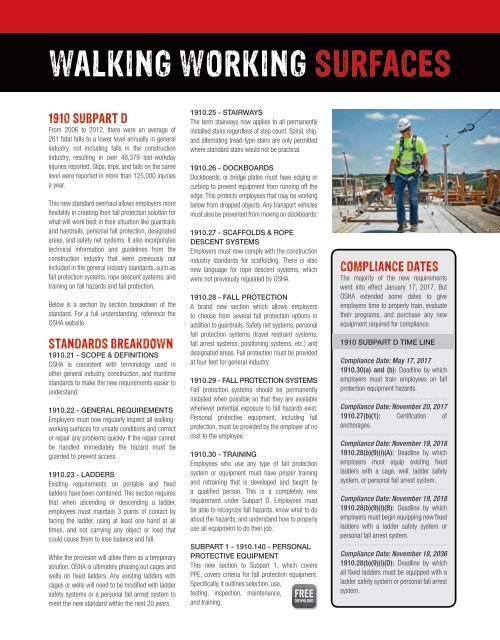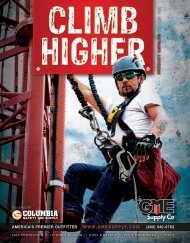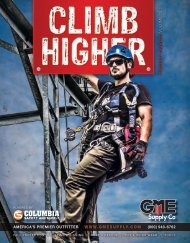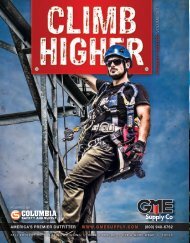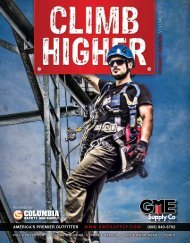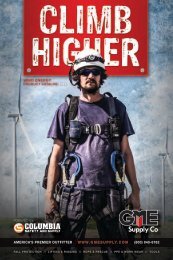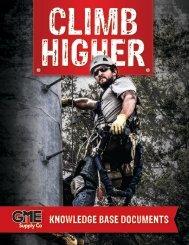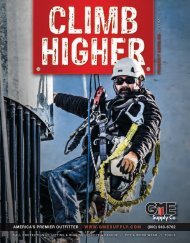GME Supply Product Catalog Version 18.1
GME Supply is North America's premier outfitter of fall protection, safety equipment, and gear for at-height workers, industry, and construction.
GME Supply is North America's premier outfitter of fall protection, safety equipment, and gear for at-height workers, industry, and construction.
Create successful ePaper yourself
Turn your PDF publications into a flip-book with our unique Google optimized e-Paper software.
WALKING WORKING SURFACES<br />
1910 SUBPART D<br />
From 2006 to 2012, there were an average of<br />
261 fatal falls to a lower level annually in general<br />
industry, not including falls in the construction<br />
industry, resulting in over 48,379 lost-workday<br />
injuries reported. Slips, trips, and falls on the same<br />
level were reported in more than 125,000 injuries<br />
a year.<br />
This new standard overhaul allows employers more<br />
flexibility in creating their fall protection solution for<br />
what will work best in their situation like guardrails<br />
and handrails, personal fall protection, designated<br />
areas, and safety net systems. It also incorporates<br />
technical information and guidelines from the<br />
construction industry that were previously not<br />
included in the general industry standards, such as<br />
fall protection systems, rope descent systems, and<br />
training on fall hazards and fall protection.<br />
Below is a section by section breakdown of the<br />
standard. For a full understanding, reference the<br />
OSHA website.<br />
STANDARDS BREAKDOWN<br />
1910.21 - SCOPE & DEFINITIONS<br />
OSHA is consistent with terminology used in<br />
other general industry, construction, and maritime<br />
standards to make the new requirements easier to<br />
understand.<br />
1910.22 - GENERAL REQUIREMENTS<br />
Employers must now regularly inspect all walkingworking<br />
surfaces for unsafe conditions and correct<br />
or repair any problems quickly. If the repair cannot<br />
be handled immediately the hazard must be<br />
guarded to prevent access.<br />
1910.23 - LADDERS<br />
Existing requirements on portable and fixed<br />
ladders have been combined. This section requires<br />
that when ascending or descending a ladder,<br />
employees must maintain 3 points of contact by<br />
facing the ladder, using at least one hand at all<br />
times, and not carrying any object or load that<br />
could cause them to lose balance and fall.<br />
While the provision will allow them as a temporary<br />
solution, OSHA is ultimately phasing out cages and<br />
wells on fixed ladders. Any existing ladders with<br />
cages or wells will need to be modified with ladder<br />
safety systems or a personal fall arrest system to<br />
meet the new standard within the next 20 years.<br />
124 <strong>GME</strong>SUPPLY.COM<br />
1910.25 - STAIRWAYS<br />
The term stairways now applies to all permanently<br />
installed stairs regardless of step count. Spiral, ship,<br />
and alternating tread-type stairs are only permitted<br />
where standard stairs would not be practical.<br />
1910.26 - DOCKBOARDS<br />
Dockboards, or bridge plates must have edging or<br />
curbing to prevent equipment from running off the<br />
edge. This protects employees that may be working<br />
below from dropped objects. Any transport vehicles<br />
must also be prevented from moving on dockboards.<br />
1910.27 - SCAFFOLDS & ROPE<br />
DESCENT SYSTEMS<br />
Employers must now comply with the construction<br />
industry standards for scaffolding. There is also<br />
new language for rope descent systems, which<br />
were not previously regulated by OSHA.<br />
1910.28 - FALL PROTECTION<br />
A brand new section which allows employers<br />
to choose from several fall protection options in<br />
addition to guardrails. Safety net systems, personal<br />
fall protection systems (travel restraint systems,<br />
fall arrest systems, positioning systems, etc.) and<br />
designated areas. Fall protection must be provided<br />
at four feet for general industry.<br />
1910.29 - FALL PROTECTION SYSTEMS<br />
Fall protection systems should be permanently<br />
installed when possible so that they are available<br />
whenever potential exposure to fall hazards exist.<br />
Personal protective equipment, including fall<br />
protection, must be provided by the employer at no<br />
cost to the employee.<br />
1910.30 - TRAINING<br />
Employees who use any type of fall protection<br />
system or equipment must have proper training<br />
and retraining that is developed and taught by<br />
a qualified person. This is a completely new<br />
requirement under Subpart D. Employees must<br />
be able to recognize fall hazards, know what to do<br />
about the hazards, and understand how to properly<br />
use all equipment to do their job.<br />
SUBPART 1 - 1910.140 - PERSONAL<br />
PROTECTIVE EQUIPMENT<br />
This new section to Subpart 1, which covers<br />
PPE, covers criteria for fall protection equipment.<br />
Specifically, it outlines selection, use,<br />
testing, inspection, maintenance,<br />
and training.<br />
COMPLIANCE DATES<br />
The majority of the new requirements<br />
went into effect January 17, 2017. But<br />
OSHA extended some dates to give<br />
employers time to properly train, evaluate<br />
their programs, and purchase any new<br />
equipment required for compliance.<br />
1910 SUBPART D TIME LINE<br />
Compliance Date: May 17, 2017<br />
1910.30(a) and (b): Deadline by which<br />
employers must train employees on fall<br />
protection equipment hazards.<br />
Compliance Date: November 20, 2017<br />
1910.27(b)(1): Certification of<br />
anchorages.<br />
Compliance Date: November 19, 2018<br />
1910.28(b)(9)(i)(A): Deadline by which<br />
employers must equip existing fixed<br />
ladders with a cage, well, ladder safety<br />
system, or personal fall arrest system.<br />
Compliance Date: November 19, 2018<br />
1910.28(b)(9)(i)(B): Deadline by which<br />
employers must begin equipping new fixed<br />
ladders with a ladder safety system or<br />
personal fall arrest system.<br />
Compliance Date: November 18, 2036<br />
1910.28(b)(9)(i)(D): Deadline by which<br />
all fixed ladders must be equipped with a<br />
ladder safety system or personal fall arrest<br />
system.


